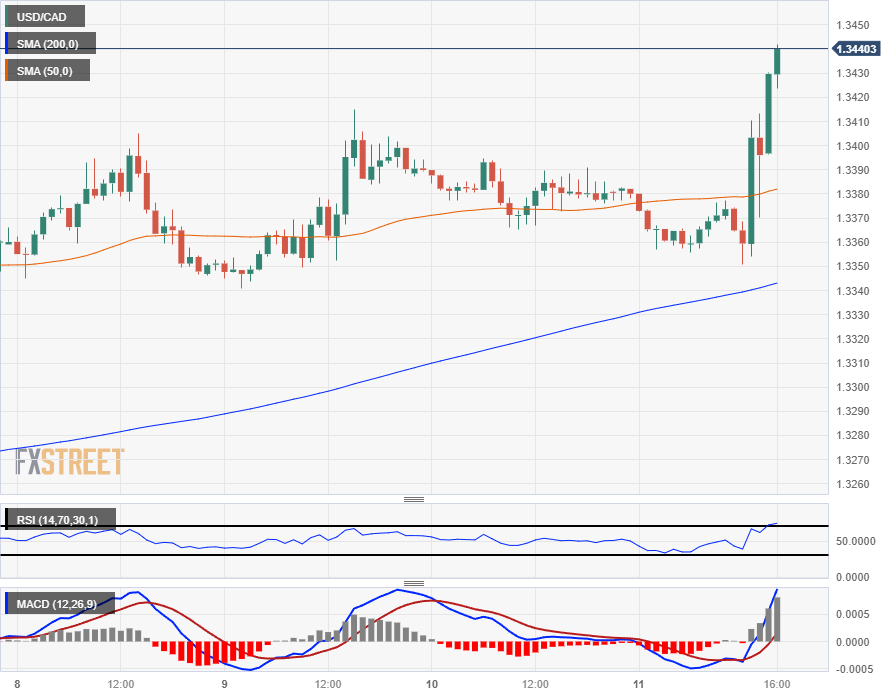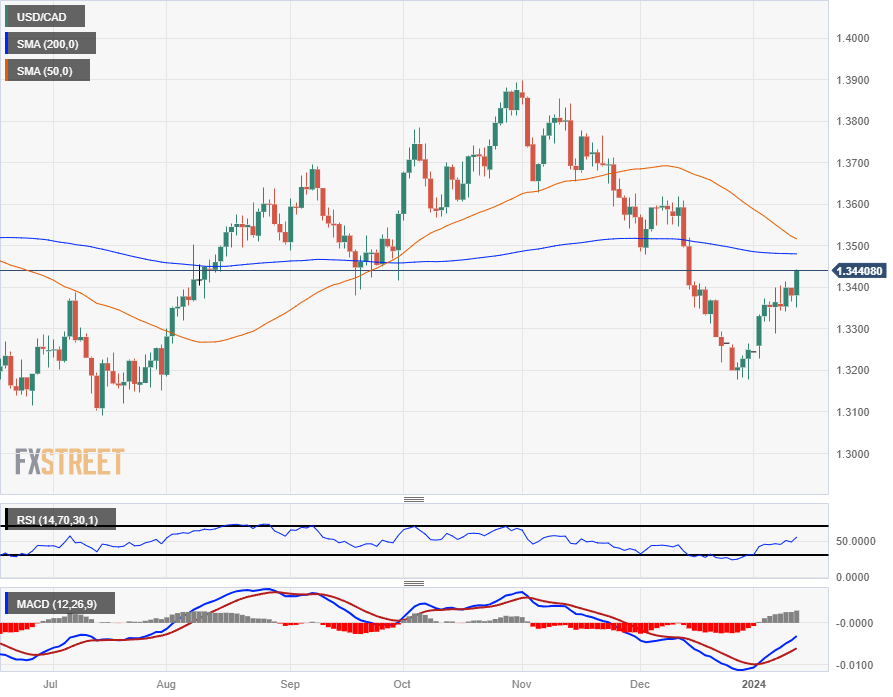- The Canadian dollar declines due to the rise in US CPI inflation.
- Economic data from Canada remains absent until next week.
- Rising inflation makes rate cuts difficult.
The Canadian Dollar (CAD) declines on Thursday as markets pivot towards safe-haven currencies after US Consumer Price Index (CPI) inflation rose more than expected, widening the gap between market hopes. market for a rate cut in March and the current stance of the Federal Reserve (Fed).
Canadian economic data remains absent from the agenda for the rest of the week, leaving CAD traders awaiting next week's Canadian CPI as well as Canadian retail sales figures for November, due out on Tuesday and Friday, respectively.
Daily summary of market movements: Canadian dollar continues to decline as markets take refuge in the safe dollar
- The Canadian dollar falls while markets bet on the US dollar after the CPI.
- US inflation is leading markets to take shelter after the US CPI vastly exceeded market forecasts.
- CAD is receiving little support from crude oil despite a short-term increase in barrel supplies, WTI is back above $73.50.
- US monthly CPI inflation rose to 0.3% in December versus the expected 0.2%, surpassing November's 0.1%.
- Annualized CPI inflation rose to 3.4% in December, above the median market forecast of 3.2% and surpassing November's annualized 3.1%.
- The annualized core CPI through December fell from 4.0% previously to 3.9%, but less than the market forecast of 3.8%.
- Despite the surprise upside in US CPI inflation, bond markets remain resilient despite the rise in safe havens and the fall in equities.
- The policy-sensitive 2-year US Treasury yield remains firmly betting on a rate cut sooner rather than later, as the yield retreats a scant 0.2%.
- Next: US Producer Price Index (PPI) inflation on Friday, where Markets expect further price declines at the front of the supply chain.
- The core PPI (overall PPI minus volatile food and energy prices) is expected to decline from 2.0% to 1.9% for the year ending December.
Canadian Dollar prices today
The following table shows the percentage change of the Canadian Dollar (CAD) against the currencies listed today. The Canadian dollar was the weakest currency against the US dollar.
| USD | EUR | GBP | CAD | AUD | JPY | NZD | CHF | |
| USD | 0.27% | 0.30% | 0.46% | 0.75% | 0.26% | 0.39% | 0.59% | |
| EUR | -0.27% | 0.03% | 0.18% | 0.49% | -0.01% | 0.08% | 0.34% | |
| GBP | -0.31% | -0.02% | 0.16% | 0.47% | -0.04% | 0.07% | 0.31% | |
| CAD | -0.47% | -0.19% | -0.15% | 0.30% | -0.20% | -0.09% | 0.17% | |
| AUD | -0.76% | -0.47% | -0.43% | -0.29% | -0.48% | -0.39% | -0.13% | |
| JPY | -0.27% | 0.00% | 0.04% | 0.17% | 0.47% | 0.07% | 0.33% | |
| NZD | -0.39% | -0.07% | -0.05% | 0.10% | 0.39% | -0.10% | 0.27% | |
| CHF | -0.60% | -0.33% | -0.30% | -0.13% | 0.16% | -0.34% | -0.22% |
The heat map shows the percentage changes of the major currencies against each other. The base currency is chosen in the left column, while the quote currency is chosen in the top row. For example, if you choose the euro in the left column and scroll down the horizontal line to the Japanese yen, the percentage change in the box will represent EUR (base)/JPY (quote).
Technical Analysis: The Canadian Dollar retreats in a wide bid of the US dollar in the market
The Canadian Dollar (CAD) retreated across the board on Thursday, gaining a quarter of a percentage point against the Australian Dollar (AUD) and a scant tenth against the Swiss Franc (CHF). Against the Japanese Yen (JPY) and the Euro (EUR), the Canadian Dollar lost a fifth of a percentage point, while against the US Dollar it fell around half a percentage point.
The Canadian dollar fell against the US dollar following the CPI release, and the USD/CAD pair approached 1.3450, after hitting a short-term low of 1.3350 on the eve of the US inflation release.
Intraday, USD/CAD bids continue above the 200 hourly moving average (SMA) near 1.3340. Prices remain above the short-term average since crossing the moving average at the start of 2024 trading.
Thursday's rally in USD/CAD drags the pair within reach of the 200-day SMA near the 1.3500 zone, but continued bullish momentum faces near-term technical resistance as the 50-SMA days retraces and heads towards a bearish crossover of the long-term moving average. USD/CAD has closed flat or bullish for nine of the last ten consecutive days of trading and is on track for a tenth day of gains.
USD/CAD is up 2% from late December bid lows near 1.3177, but is still down around 3.3% from October's high near the 1.3900 area.
USD/CAD Hourly Chart
USD/CAD Daily Chart
Frequently Asked Questions about the Canadian Dollar
What factors determine the price of the Canadian dollar?
The key factors that determine the price of the Canadian dollar (CAD) are the level of interest rates set by the Bank of Canada (BoC), the price of oil, Canada's main export product, the health of its economy, inflation and the trade balance, which is the difference between the value of Canadian exports and its imports. Other factors are market confidence, that is, whether investors bet on riskier assets (risk-on) or look for safe assets (risk-off), with the risk-on being positive for the CAD. As its largest trading partner, the health of the US economy is also a key factor influencing the Canadian dollar.
How do Bank of Canada decisions affect the Canadian dollar?
The Bank of Canada (BoC) exerts significant influence over the Canadian Dollar by setting the level of interest rates that banks can lend to each other. This influences the level of interest rates for everyone. The BoC's main objective is to keep inflation between 1% and 3% by adjusting interest rates up or down. Relatively high interest rates are usually positive for the CAD. The Bank of Canada can also use quantitative easing and tightening to influence credit conditions, with the former being negative for the CAD and the latter being positive for the CAD.
How does the price of oil affect the Canadian dollar?
The price of oil is a key factor influencing the value of the Canadian Dollar. Oil is Canada's largest export, so the price of oil tends to have an immediate impact on the value of the CAD. Generally, if the price of oil rises, the CAD also rises, as aggregate demand for the currency increases. The opposite occurs if the price of oil falls. Higher oil prices also tend to lead to a higher probability of a positive trade balance, which also supports the CAD.
How does inflation data influence the value of the Canadian Dollar?
Although inflation has traditionally always been considered a negative factor for a currency, as it reduces the value of money, the opposite has actually happened in modern times, with the relaxation of cross-border capital controls. Higher inflation often leads central banks to raise interest rates, attracting more capital inflows from global investors looking for a lucrative place to store their money. This increases the demand for the local currency, which in the case of Canada is the Canadian Dollar.
How does economic data influence the value of the Canadian dollar?
The published macroeconomic data measures the health of the economy and may have an impact on the Canadian dollar. Indicators such as GDP, manufacturing and services PMIs, employment and consumer confidence surveys can influence the direction of the CAD. A strong economy is good for the Canadian dollar. Not only does it attract more foreign investment, but it may encourage the Bank of Canada to raise interest rates, resulting in a stronger currency. However, if economic data is weak, the CAD is likely to fall.
Source: Fx Street
I am Joshua Winder, a senior-level journalist and editor at World Stock Market. I specialize in covering news related to the stock market and economic trends. With more than 8 years of experience in this field, I have become an expert in financial reporting.









